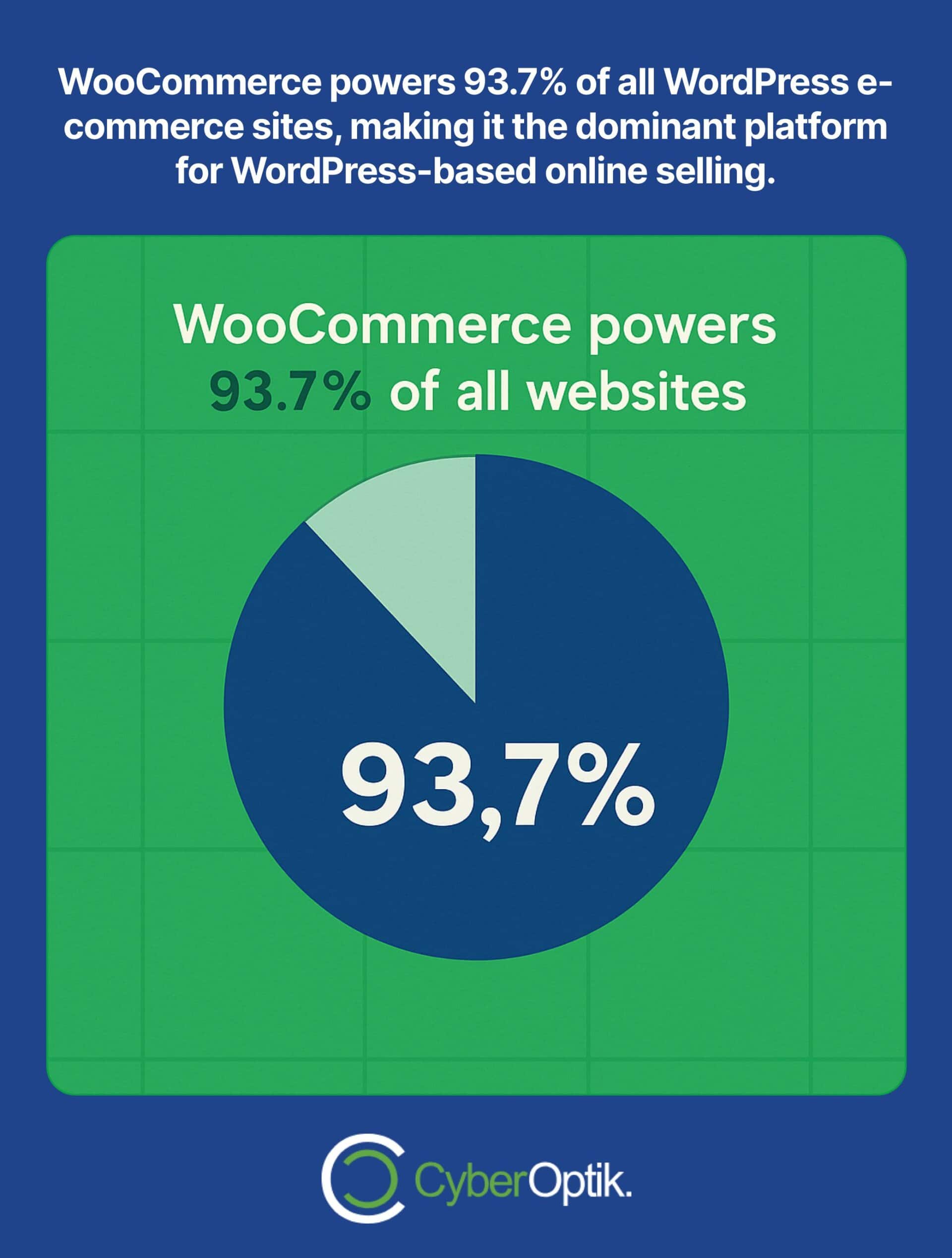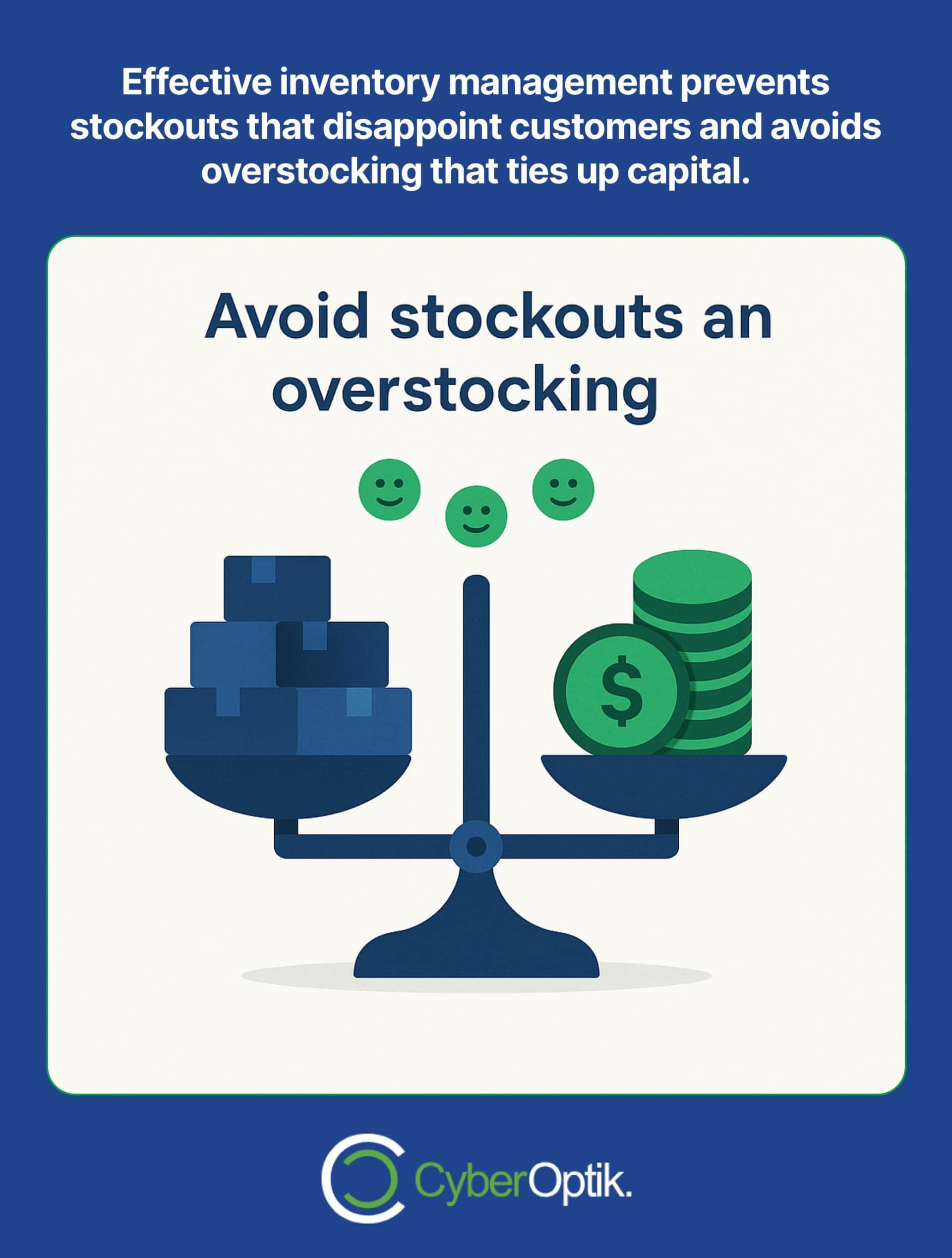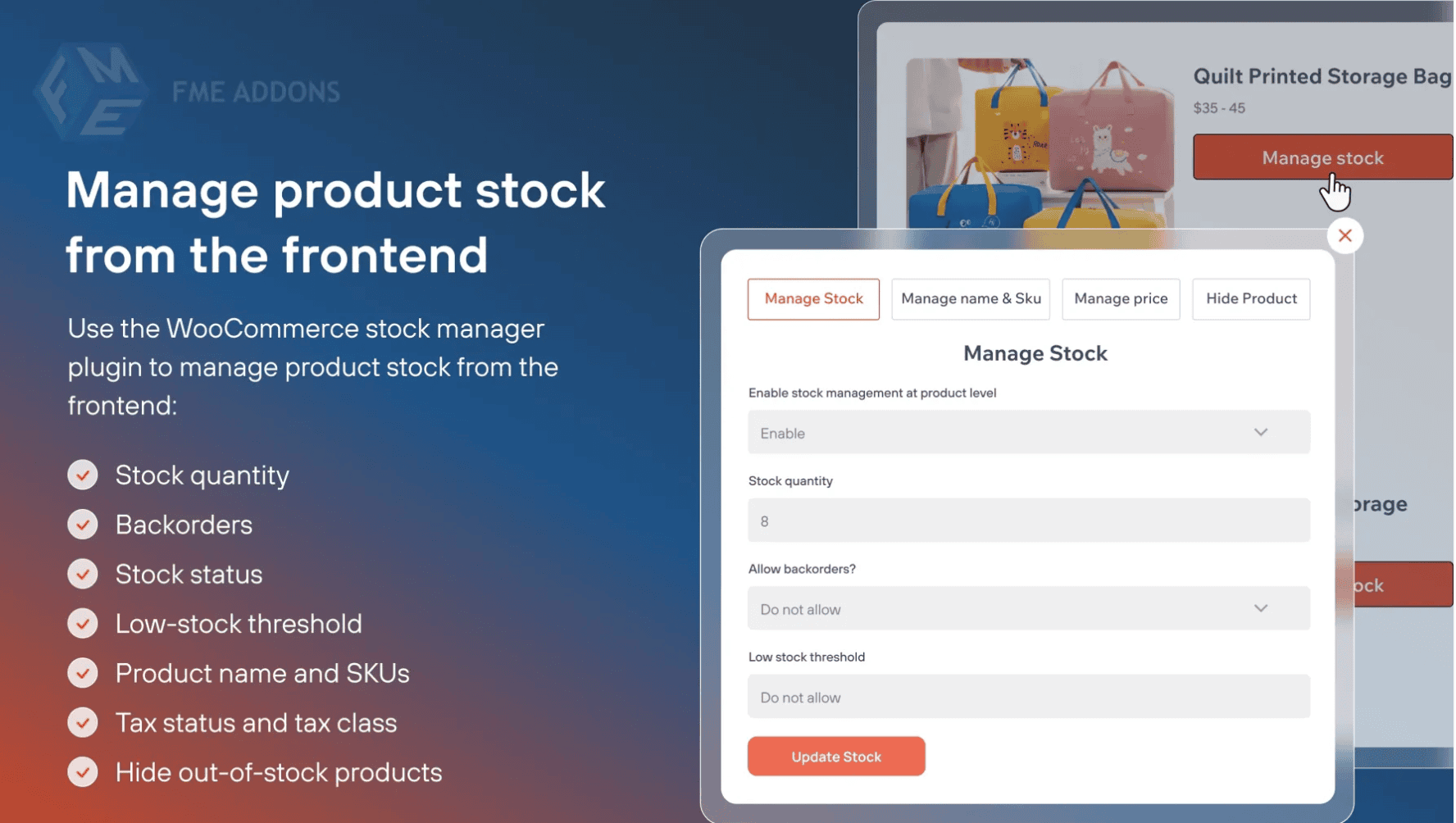Effective inventory management can make or break your online store. As e-commerce continues to grow, maintaining accurate stock levels becomes increasingly critical for business success. Poor inventory management leads to overselling, stockouts, and frustrated customers.

Our team at CyberOptik works with numerous e-commerce businesses who rely on WordPress for their online stores. WooCommerce powers 93.7% of all WordPress e-commerce sites, making it the dominant platform for WordPress-based online selling.
In this article, we’ll explore the top five WordPress inventory management plugins that can transform how you track products, manage stock, and optimize your e-commerce operations. These tools offer solutions to common inventory challenges while integrating seamlessly with your existing WordPress setup.
Let’s explore how these plugins can help streamline your inventory processes and improve your overall business efficiency.
Understanding Inventory Management for WordPress E-commerce
Inventory management directly affects your bottom line. Effective systems prevent stockouts that disappoint customers and avoid overstocking that ties up capital. The right tools make all the difference.

WordPress powers over 40% of all websites online today, with WooCommerce claiming a 23.43% share of the entire e-commerce market. This massive adoption creates a need for specialized inventory solutions.
Many store owners struggle with inventory challenges. These include maintaining accurate counts across multiple sales channels, forecasting future inventory needs, and tracking product variants. Manual systems often lead to errors and wasted time.
The business cost of poor inventory management is substantial. Stockouts can lead to an immediate loss of sales and, worse, long-term customer loyalty. Meanwhile, overstocking ties up capital and creates storage costs.
WordPress inventory plugins solve these issues by automating stock tracking, providing real-time updates, and offering detailed reporting. They integrate with your existing WordPress installation to enhance its native capabilities.
Key Features to Look for in WordPress Inventory Management Plugins
Not all inventory plugins offer the same functionality. When selecting a solution for your online store, certain features prove essential. The right choice depends on your specific business needs.
Here are the critical features we recommend our clients consider when evaluating inventory management plugins:
| Feature Category | Important Elements | Business Benefit |
|---|---|---|
| Core Inventory Functions | Stock level tracking, low stock alerts, batch updates | Prevents stockouts and overselling |
| Integration Capabilities | POS systems, shipping providers, accounting software | Creates unified business systems |
| Reporting & Analytics | Sales forecasting, inventory turnover reports, cost tracking | Enables data-driven decisions |
| User Experience | Intuitive interface, bulk editing, mobile compatibility | Reduces staff training time |
Integration capabilities deserve special attention. Your inventory plugin should connect seamlessly with your e-commerce platform and other business tools to create a unified system.
Reporting features help you spot trends and make informed purchasing decisions. Look for solutions that provide actionable data rather than just raw numbers. Visual reports often prove most valuable for quick insights.
Automation options save significant time and reduce human error. Features like automatic purchase orders, reorder point triggers, and stock level adjustments streamline operations. The best systems require minimal manual intervention.
Scalability matters, especially for growing businesses. Will the plugin handle 10,000 products as smoothly as it manages 100? Can it accommodate multiple warehouses or locations? Consider your future needs when selecting a solution.
Top 5 WordPress Inventory Management Plugins Reviewed
After working with numerous e-commerce clients, we’ve identified the standout inventory management solutions for WordPress stores. Each offers unique advantages for different business needs. Let’s examine them in detail.
1. ATUM Inventory Management for WooCommerce

ATUM stands as the most comprehensive inventory solution for WooCommerce stores. This plugin goes beyond basic stock management to provide an integrated business control system. Its modular approach suits businesses of all sizes.
The core ATUM plugin offers features like inventory status, stock control, and purchase orders. Premium add-ons extend functionality with tools for product levels, suppliers, multi-inventory, and more. This flexibility allows businesses to scale their solution as needed.
| Key Features | Available In |
|---|---|
| Inventory List & Stock Central | Free Version |
| Purchase Orders | Free Version |
| Inventory Logs | Free Version |
| Multi-Inventory Management | Premium Add-on |
| Supplier Management | Premium Add-on |
ATUM excels in its reporting capabilities. The Stock Central dashboard provides a real-time overview of your entire inventory with customizable filters and views. This makes spotting inventory issues or opportunities much easier.
The user interface deserves special mention. ATUM features a clean, modern dashboard that simplifies complex inventory management tasks. The visual stock management system helps users quickly assess inventory status.
ATUM ranks as a top choice for order management in the WooCommerce ecosystem. Its comprehensive approach and regular updates make it a reliable solution for serious e-commerce operations.
While the free version offers substantial functionality, most businesses benefit from the premium add-ons. These add specialized features like barcode scanning, supplier management, and multi-inventory capabilities that larger operations often require.
2. WooCommerce Stock Manager

WooCommerce Stock Manager provides a streamlined approach to inventory management. This plugin focuses on making stock adjustments as simple as possible. Its lightweight design means minimal impact on site performance.
The main advantage here is simplicity. The plugin creates a dedicated interface for managing stock quantities, prices, and SKUs from a single screen. This eliminates the need to edit individual products, saving significant time.
Bulk operations set this plugin apart. Store owners can update stock across multiple products simultaneously, import/export inventory via CSV, and make quick adjustments when receiving new merchandise. These features particularly benefit stores with frequent inventory changes.
The plugin works well for stores with the following characteristics:
- Small to medium product catalogs (under 1,000 SKUs)
- Frequent inventory updates or restocking
- Limited technical resources or staff training capabilities
- Need for CSV import/export functionality
WooCommerce Stock Manager lacks some advanced features found in other solutions. It doesn’t offer supplier management, purchase orders, or detailed analytics. However, its focused approach meets the needs of many small businesses.
The plugin’s pricing makes it accessible for smaller operations. At a fraction of the cost of comprehensive solutions, it provides essential inventory management functions without overwhelming users with complex features they may not need.
We find this plugin particularly valuable for clients transitioning from manual inventory tracking to their first automated system. Its intuitive interface reduces the learning curve while still providing significant efficiency improvements.
3. Easy Digital Downloads (EDD)
Easy Digital Downloads serves a specific niche: businesses selling digital products. While not exclusively an inventory plugin, EDD includes stock management features tailored to digital goods. This specialized focus makes it ideal for certain businesses.
Digital products present unique inventory challenges. Unlike physical goods, they don’t deplete in the traditional sense but may have licensing or access limitations. EDD handles these scenarios elegantly with features built specifically for digital inventory.
The licensing management system stands out as particularly valuable. Store owners can track licenses issued, monitor activations, and control usage limits. This functionality proves essential for software, themes, plugins, and other licensed digital products.
| Digital Product Type | How EDD Manages Inventory |
|---|---|
| Software/Plugins | License key generation and activation tracking |
| Digital Media (Music/Video) | Download limits and access control |
| E-books/PDFs | File delivery and download monitoring |
| Subscription Content | Recurring access management |
Beyond inventory, EDD provides a complete sales system for digital products. The platform handles payment processing, tax calculations, discount codes, and customer management. This integration creates a seamless experience for both merchants and customers.
The EDD ecosystem includes numerous extensions that enhance its inventory capabilities. These add-ons enable features like product bundles, wishlist functionality, and restricted content access. The modular approach allows businesses to customize their setup.
For mixed product stores (both physical and digital), EDD can work alongside WooCommerce. This combination allows businesses to leverage the strengths of each platform for the appropriate product types.
4. Wholesale Suite
Wholesale Suite addresses inventory management within the B2B context. This solution focuses on wholesale operations where bulk inventory management, tiered pricing, and customer-specific catalogs become essential. It extends WooCommerce’s capabilities for business-to-business selling.
The suite consists of three main components: Wholesale Prices, Wholesale Order Form, and Wholesale Lead Capture. Together, these create a comprehensive system for managing wholesale inventories and customers. Each component addresses specific wholesale challenges.
Inventory features include:
- Customer-specific product visibility controls
- Role-based inventory access and pricing
- Minimum and maximum quantity rules
- Fast order forms for efficient wholesale purchasing
- Bulk inventory management tools
The Wholesale Order Form component particularly enhances inventory operations. It creates a streamlined interface where wholesale customers can quickly order multiple products, view their specific pricing, and check stock availability. This efficiency benefits both buyers and sellers.
For businesses selling to both retail and wholesale customers, the plugin maintains separate inventory rules and displays. This separation allows for different minimum quantities, pricing structures, and product availability based on customer type.
The reporting system provides insights into wholesale inventory movement. These reports help identify high-performing products, forecast wholesale demand, and optimize stock levels for B2B sales channels. Data-driven decisions improve inventory efficiency.
Integration with various shipping and fulfillment systems supports wholesale operations. The plugin works with major shipping providers to calculate accurate rates for bulk orders, a critical feature for wholesale inventory management.
5. Smart Manager for WooCommerce
Smart Manager takes a spreadsheet-like approach to WooCommerce inventory management. This interface will feel instantly familiar to anyone who uses Excel or Google Sheets for inventory tracking. The familiar format reduces the learning curve significantly.
The plugin creates a centralized dashboard for managing products, orders, customers, and other WooCommerce data. This consolidated view eliminates the need to navigate through multiple WordPress admin screens. All inventory information appears in one place.
Key inventory capabilities include:
| Feature | Business Benefit |
|---|---|
| Inline editing | Make quick changes without opening individual products |
| Batch update | Modify multiple products simultaneously |
| Advanced search/filters | Quickly find products that need attention |
| Custom views | Create personalized inventory dashboards |
The search and filter system deserves special mention. Users can create complex queries to find products meeting specific criteria – such as low stock items within certain categories or products with particular attributes. These targeted views streamline inventory management.
Smart Manager includes automation features for routine inventory tasks. Users can create and save batch update actions for repeated use, schedule automatic stock adjustments, and set up custom workflows. These automations save significant time for busy store managers.
While not exclusively focused on inventory, Smart Manager’s approach makes it particularly effective for stores with diverse product catalogs. The ability to quickly sort, filter, and modify large product collections helps maintain accurate inventory across complex assortments.
The free version offers basic functionality, making it accessible for testing. However, most businesses will benefit from the premium version’s advanced features, particularly the powerful batch update capabilities and saved views.
Comparing WordPress Inventory Management Solutions
Choosing the right inventory plugin depends on your specific business needs. Each solution offers different strengths for various scenarios. We’ve compared the key factors to help guide your decision.
The following comparison table highlights the main differences between these top WordPress inventory management plugins:
| Plugin | Best For | Standout Feature | Pricing Model | Technical Complexity |
|---|---|---|---|---|
| ATUM | Comprehensive inventory management | Complete inventory control system | Freemium with paid add-ons | Medium-High |
| WooCommerce Stock Manager | Simple inventory updates | Spreadsheet-like bulk editing | One-time purchase | Low |
| Easy Digital Downloads | Digital product stores | License and download management | Subscription with tiers | Medium |
| Wholesale Suite | B2B and wholesale operations | Role-based pricing and ordering | Bundle pricing | Medium |
| Smart Manager | Efficient product management | Spreadsheet interface with advanced search | Freemium with premium version | Low |
For small stores just starting out, WooCommerce Stock Manager or the free version of Smart Manager typically provides sufficient functionality. These solutions offer essential inventory features without overwhelming new users or straining limited budgets.
Medium-sized businesses with growing product catalogs generally benefit from ATUM’s balanced approach. The free core plugin offers substantial functionality, while premium add-ons allow for expansion as the business scales. This flexibility provides room to grow.
Specialized businesses have specific needs. Digital product sellers should prioritize Easy Digital Downloads, while wholesale operations will find Wholesale Suite’s B2B features invaluable. Using the right specialized tools can significantly reduce operational costs compared to generic solutions.
Performance impact varies between plugins. Lighter solutions like WooCommerce Stock Manager have minimal effect on site speed. More comprehensive options like ATUM may require optimization for very large catalogs. Always test performance with your specific setup.
Implementation Best Practices for Inventory Management Plugins
Successfully implementing an inventory management plugin requires planning. A strategic approach ensures smooth adoption with minimal disruption to your operations. We’ve guided many clients through this process.
Start with a complete inventory audit. Before implementing any new system, verify your current stock counts and product information. This step establishes an accurate baseline and prevents carrying existing errors into the new system.
Data preparation makes a significant difference. Clean up your product database by:
- Standardizing SKUs and product naming conventions
- Verifying product attributes and categories
- Updating product images and descriptions
- Removing obsolete or duplicate products
- Setting appropriate stock status for all items
Staff training proves essential for successful adoption. Even the most powerful inventory system fails if your team doesn’t use it correctly. Create standard operating procedures and provide hands-on training before full implementation.
Always test in a staging environment first. What happens when you install a new plugin on your live site without testing? Often, compatibility issues or configuration problems emerge. A staging site allows for safe testing before affecting your live store.
Consider your backup strategy carefully. Inventory data represents critical business information. Regular backups protect against data loss during the transition and beyond. Reliable backup plugins ensure your inventory data remains protected throughout the implementation process.
Integration with other business systems requires attention. Many businesses use accounting software, CRM systems, or shipping platforms alongside WordPress. Ensure your inventory plugin can exchange data with these systems to prevent information silos.
Common Challenges and Solutions
Even the best inventory management plugins come with potential challenges. Knowing these common issues and their solutions helps you implement preventative measures. We’ve compiled the most frequent problems our clients encounter.
Performance impacts often concern store owners. Inventory plugins can affect site speed, especially with large product catalogs. WordPress powers 43% of all websites on the internet, but performance varies greatly based on configuration.
| Common Challenge | Solution Approach |
|---|---|
| Slow admin dashboard | Optimize database, upgrade hosting, implement caching |
| Inventory sync issues | Use dedicated sync tools, schedule regular reconciliation |
| Data import problems | Clean CSV files, follow template formats, test with small batches |
| Plugin conflicts | Test compatibility, reduce unnecessary plugins, use staging environment |
Multi-channel selling presents particular challenges. When selling through multiple platforms (website, Amazon, physical store, etc.), inventory synchronization becomes critical. Specialized solutions or middleware may be necessary to maintain accurate counts across channels.
Data management grows more complex with scale. Stores with thousands of products, multiple variations, or frequent inventory changes face significant data handling challenges. Implement structured processes for inventory updates and leverage automation whenever possible.
Security concerns merit attention when handling inventory data. Limiting user access permissions, implementing two-factor authentication, and maintaining regular updates help protect sensitive business information. Always follow WordPress security best practices.
Customer experience depends on accurate inventory. Showing incorrect availability frustrates customers and damages trust. Configure your system to temporarily hide products rather than showing “out of stock” for items that will quickly be replenished.
Conclusion
Selecting the right inventory management plugin transforms how your WordPress store operates. The best solution aligns with your specific business needs, technical capabilities, and growth plans. No single plugin works perfectly for every store.
ATUM stands out for comprehensive inventory management needs. Its modular approach allows businesses to start with core features and expand as requirements grow. For most established WooCommerce stores, this represents the most complete solution.
Smaller operations often benefit from WooCommerce Stock Manager or Smart Manager. These plugins provide essential inventory functionality without overwhelming complexity. Their intuitive interfaces reduce the learning curve for new users.
Specialized businesses should prioritize solutions designed for their needs. Digital product sellers will find EDD’s unique inventory approach invaluable, while wholesale operations gain significant advantages from Wholesale Suite’s B2B features.
Regardless of which plugin you choose, proper implementation makes the difference between success and frustration. Follow our best practices for setup, maintain regular backups, and ensure your team receives adequate training.
As your business grows, regularly reassess your inventory management needs. What works for 100 products might struggle with 1,000. Be prepared to evolve your approach as your store expands and your processes become more sophisticated.
Need help selecting or implementing the right inventory management solution for your WordPress store? Our team at CyberOptik specializes in WordPress e-commerce solutions. We can help you evaluate options, implement your chosen system, and train your team for success.




